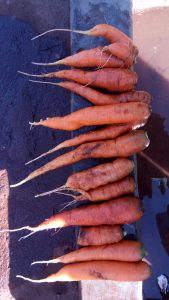 Never in his life had he seen carrot seeds, yet when he happened to cast his eyes on them, he still doubted if they were the ones! Abdullie*, one of the children under rehabilitation from the streets at S.A.L.V.E land showed great amusement when the teacher presented to the class several vegetable seeds. Carrots are a biannual vegetable crop which is believed to have originated from Persia and other parts of the eastern world as a wild crop majorly used for medicinal with time became a great food item as it slowly found its way to Spain and to other parts of Europe. I believe the crop was introduced to Africa and Uganda in particular by way of our colonial past and it became adopted as a vegetable on many tables of wealthy members of the community since such foods are by and large said to belong to a “higher class” of people, a mythical belief held by many regarding some crops.
Never in his life had he seen carrot seeds, yet when he happened to cast his eyes on them, he still doubted if they were the ones! Abdullie*, one of the children under rehabilitation from the streets at S.A.L.V.E land showed great amusement when the teacher presented to the class several vegetable seeds. Carrots are a biannual vegetable crop which is believed to have originated from Persia and other parts of the eastern world as a wild crop majorly used for medicinal with time became a great food item as it slowly found its way to Spain and to other parts of Europe. I believe the crop was introduced to Africa and Uganda in particular by way of our colonial past and it became adopted as a vegetable on many tables of wealthy members of the community since such foods are by and large said to belong to a “higher class” of people, a mythical belief held by many regarding some crops.
Having adopted permaculture as part of the subjects taught at the S.A.L.V.E land under the Learning for Life education program, we decided to begin our adventure with vegetable production. My class was not ready to wait long before they saw tangible results! One of the crops we have raised is carrots. To do this, we had to go through the necessary steps and put in place conditions for a perfect harvest.
Conditions required for carrot growth;
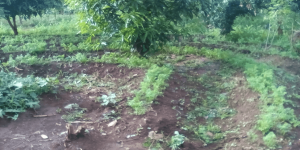
Carrots, just like all root crops, do prefer friable soils to ease their penetration downwards. The soils should be well drained, and enriched with nutrients for proper root growth. We achieved these conditions at our S.A.L.V.E land by raising soil to come up in raised beds. The major garden is in a U shape formulating a nice design on the land as seen in the photograph. We made use of tools like hand hoes, forked hoes, spades and a wheel barrow to create these.
Soil Improvements:
Having this in mind, the challenge was with the nature of soil at the land which was totally depleted and needed healing. The fertility was improved by use of compost in the form of chicken house refuse sourced from a neighbouring farm, mixed with forest soil which we accessed from underneath the hedge. This has a rich supply of freely decomposing organic material. This was a sure way of achieving a good harvest since we gained confidence in the fertility of the soil – a crucial pre condition for achieving the best outcomes.
The above activities called for a considerable labour input and some of my students were reluctant to join in! “I left home because of digging so am not digging again here”
I was discouraged, but I averted these negative attitudes by promises of a good share at harvest time and explaining to them how easy an activity it was. We carried out all of our activities with speed, and in a short time we had our garden ready for sowing.
Sowing;
The most commonly used carrot variety in Uganda is the Nantes which is fast growing, easy to grow and can adapt to a range of climatic conditions and so we decided to use the same variety. Having made the soil ready, the next step was sowing. Unlike other vegetables, carrots are not usually first planted in the nursery bed because at transplanting age, their roots are not yet strong enough to be established in another soil in the main seed bed. So in this case we used the direct sowing method. It was of great interest when our carrots were sprouting that wild rabbits showed up near the garden because of the pleasant smell that carrots seeds produce while sprouting. These rabbits however risked finding themselves in soup because my students had told me of stories about preying on wild rabbits!
Field maintenance:
We managed to maintain our garden at S.A.L.V.E by continuous pulling of weeds by hand because using a hoe would injure the young shoots. We carried out thinning at the right age and we came up with a garden well spaced and heavy with vigorously growing carrots. Carrots grown under well managed conditions are not so prone to pests though they suffer from some, the major one being carrot rust flies, aphids, mice, and diseases like damping off, soft rot and others causing rotting and lesions on the bulbs. These can be overcome by implementation of a systematic Integrated Pest Management programme.
Harvests:
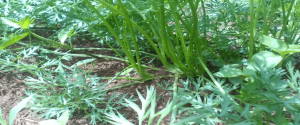
A carrot garden is not usually harvested all at once because some bulbs gain a reasonable size before others do. In this case, farmers thin out the big ones at two and half months and leave the smaller ones room to grow even bigger. Before pulling out your carrots, use a fork to loosen the soil just outside the row. Then pull sown carrots when roots reach mature size and show rich color.
Taste improves as carrots mature. However, don’t leave mature carrots in warm soil any longer than necessary, and store only the best undamaged roots. Cut off their foliage and lay the roots between layers of sand in a strong box. Remove any odd rotten roots before they infect others.
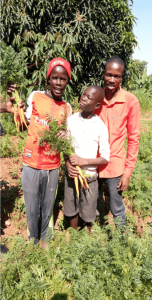
Many people do not like sowing and the other activities involved but do cherish the harvesting moment! The thin green leaves around the garden bore “golden” roots in terms of bright orange edible bulbs!
Many of these were eaten raw at this moment but we are planning to use these harvests to reduce our vegetable expenses and to help reduce vitamin A deficiencies among our children. Such a garden can be cultivated again in the coming season after top dressing with compost manure.
The jovial students here participated from the very beginning of our permaculture programme, and put all their effort into the work given to them!
Ways of putting the carrot crop to use;
There are many ways in which carrots can be used locally. The major way is to use it as an accompaniment in foods like beans and other kinds of local dishes. Many people eat them in their raw state immediately after harvesting, and the only processing done here is washing. Others crush them and mix them with fresh fruit juices while others still dry them with recommended solar driers and package them or eat them on a later date as dry crisps.
Choose for yourself the most convenient way to use your carrot harvests!
At S.A.L.V.E. land, we used this opportunity to use more carrots as ingredients in most of the dishes that were prepared during the harvest season;
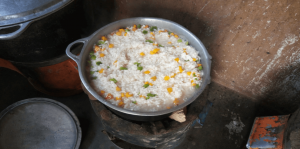
The Fame of the Crop in Uganda:
In Uganda, carrots are majorly grown in the western part of the country in areas like Kabale, Kisoro and Rukungiri districts while in the eastern part, the vegetable is grown in Mbale, Sironko and Tororo districts, characterised by very volcanic, fertile soil. Such conditions can be achieved in other areas like Jinja where S.A.L.V.E land is located by use of compost manure, liquid manures, and other soil/water conservation measures as we learn during our lessons. The crop is highly demanded by all Ugandans and is always evident in any major market or food store. Carrots are even on sale in small remote markets that are usually found along footpaths with other fruits and leafy vegetables.
Teach not a man how to fish, rather teach him how to own the pond!
The children have expressed a great deal of joy and excitement at the sight of “real” carrots from the base of the plants. Many of those resettled have promised to try out carrot cultivation once they reach their homes. Others have opened up their own small gardens where each is expecting a harvest!
A small seed tin of 50 grams can raise a reasonable garden. If well sowed, with favourable conditions put in place, one can harvest approximately two sacks which can produce over 70 kilograms each! With the average cost of each kilogram at 2,000 Ugandan shillings, this can change a person’s life with consistent production. I advise my students to try out most of the gardening techniques once they get to their homes so as to reduce the amount of food bought from the markets. It also allows them to gain an income when they have surplus products for sale. Mass production can attract bigger business, even up to export level, since most of the carrots in Uganda’s markets are imported from neighbouring Kenya.
End notes:
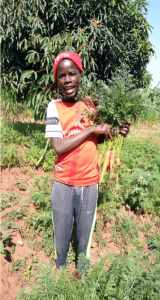 To wrap this up, education at S.A.L.V.E land is all around. We endeavour to educate the children we work with in all facets of life. This will be a good avenue for keeping children off the streets of Jinja and other towns in Uganda. Once they are resettled, sustainable farming skills are a realistic skill that the family can benefit from. The study of permaculture has added excitement into the students’ learning experience. Knowledge about their environment, gardening and how nature relates to all corners of life has led to improved mindsets about care and maintenance of our environment. In the near future, we hope to introduce more appropriate technology topics such as recycling and how to easily carry out more work on farms and homesteads with little efforts. On this note I call upon all well wishers to join the call of S.A.L.V.E International and erase the term “street children” from the vocabulary of town dwellers mainly in Jinja and other town centres all over Uganda for “There is no street called home!”
To wrap this up, education at S.A.L.V.E land is all around. We endeavour to educate the children we work with in all facets of life. This will be a good avenue for keeping children off the streets of Jinja and other towns in Uganda. Once they are resettled, sustainable farming skills are a realistic skill that the family can benefit from. The study of permaculture has added excitement into the students’ learning experience. Knowledge about their environment, gardening and how nature relates to all corners of life has led to improved mindsets about care and maintenance of our environment. In the near future, we hope to introduce more appropriate technology topics such as recycling and how to easily carry out more work on farms and homesteads with little efforts. On this note I call upon all well wishers to join the call of S.A.L.V.E International and erase the term “street children” from the vocabulary of town dwellers mainly in Jinja and other town centres all over Uganda for “There is no street called home!”
As I write this, we still vividly celebrate the emergence of “golden” roots to our land!
One final thought to leave you with is that a carrot is not just a food but can even be a musical instrument…. Find out more by clicking here!

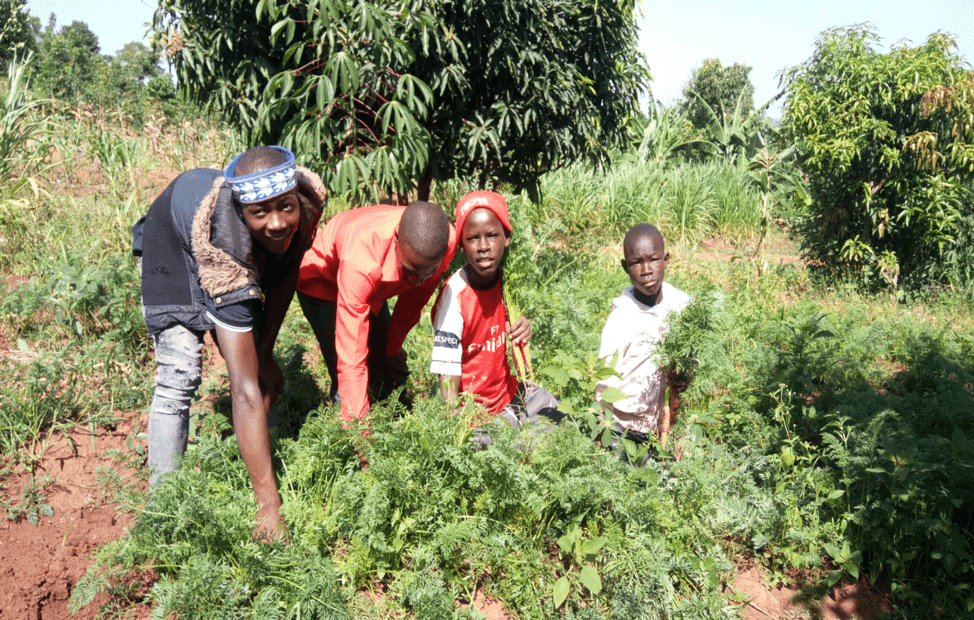

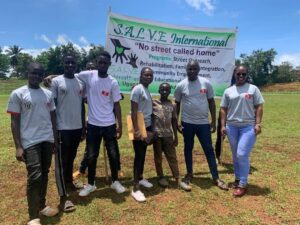
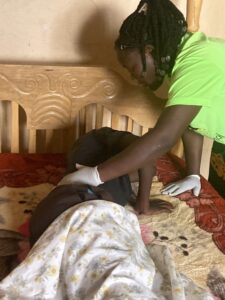
0 Comments